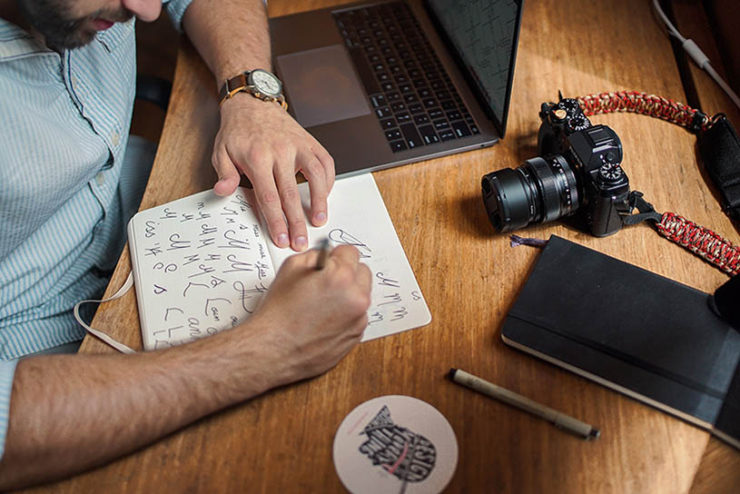The process of designing a logo can be quite arduous – and arguably should be, if done right. But it doesn’t necessarily have to give you gray hairs and make you feel like knocking your head against your desk. The important thing to remember is to trust your intuition, let your ideas flow naturally during the early stages and to try not to overthink your designs.
In addition, here is a list of four key things to keep in mind when you are tasked with the (rather significant) responsibility of designing and creating a logo. This list is not exhaustive, and doesn’t cover such technical details as which file formats are best for logos, recommended logo sizes/dimensions, etc. Rather, I’m simply trying to paint an honest picture of my personal observations and experiences of the more abstract aspects of logo design and creation.
1) Don’t take things too literally…
Sometimes it can be difficult to resist the urge to interpret your subject matter too literally. Don’t fall into this trap! For example, if you’re designing a logo for a library, try to resist the urge to draw the outline of the actual library or create a literal book image. I recently completed a project that involved creating a logo for my local library. As I was brainstorming ideas in the early design stages, I kept coming back again and again to the concept of books, and consequently had to keep stopping myself from reverting back to that cliché. After forcing myself to think outside the box (speaking of tired old clichés… ) and focus on what this library truly represents to the community – only then did I come up with better, more inventive designs to show my client.
A logo should convey a little bit of information and a little bit of emotion. Strive for a balance of these two concepts.
Remember, what you’re primarily trying to convey is a feeling or an idea – focus on the main emotion you’re trying to evoke when someone sees your logo. And try to steer clear of overly detailed, literal representations of people or objects. The Prudential logo is a rock – yes – but it doesn’t have tons of details and you can’t see all the nooks and crannies or moss growing on that rock image. That logo doesn’t need to convey all of the information of what a rock looks like… it’s more important to focus on the idea that the rock symbol represents. The next time you’re designing a logo, ask yourself, “what does this image need to represent, and what is the most important thing I’m trying to say with this logo?” Then ask yourself, “can I still say the same thing with fewer details?”
Some of the more effective, innovative logos are non-representational and rather simple. To name a few – Nike, Adidas, and Reebok all have excellent, smart, clean logos.
2) Make sure you do your research…
When designing a logo for a client, there’s nothing worse than spending hours upon hours and perhaps days or weeks – only to discover that a very similar design already exists out there in cyberspace (unfortunately, I say this from experience). A while back, I met with a client, learned all about her business then set to work designing her what I thought was a brilliant logo. After spending a week creating a zillion different sketches for her to choose from (I went way overboard – don’t do this!) we met to go over my design concepts. She chose one that caught her eye: “I LOVE this one!” she stated gleefully.
After spending another week actually creating not one logo in Photoshop, in my zealous state I created 8 different variations of this same concept. I was eager to please and to be honest, got carried away with all the creative possibilities. To make a long story short, two weeks had gone by when a random internet search brought up almost the same exact logo design, on another business’ website. And the business was in the same exact industry that my client was in. What I thought was my own unique idea had already been thought of by some other designer. This resulted in my scrapping the whole concept and starting over. So research first; then design.
3) Design for flexibility and scalability…
One of the most important things to remember when actually executing a logo design in Photoshop, Canva or whatever – is that your design has to work in multiple different file formats, sizes, and colors. It will potentially be used for many different purposes. It might be displayed on t-shirts, on banners that are hung outside, on mousepads, in favicons, etc. as well as on the more traditional materials such as business cards, brochures and websites.
Go for simplicity over trying to cram as many details in as you can. Logos aren’t meant to say everything about a company – they’re mainly meant to be a visually appealing way for customers to identify the company. The more simple the logo is the easier it will be for customers to remember it. And of course the more simple a logo is the easier it will be to scale it down to business card size, or to scale it up to the size of an outdoor sign.
One of the logos I designed a few years ago was displayed on brochures and other printed materials, on a website and on a sign that was hung outside of a building. It was also emblazoned in wood at the altar of a church. Plus, when designing for a non-profit especially, it will be cheaper for the client to get the logo printed if it has fewer colors.
4) Be aware of what you’re up against…
Being a logo designer just isn’t what it used to be, and true designers might be a dying breed. My design mentor has owned his own graphic design business for 35 years and specializes mostly in printed materials. I majored in Graphic Design in college and was in the web dev and design business before the invention of the internet, so I totally get where he’s coming from. When I first set out on my own as a freelancer, I asked him for some advice on pricing my logo design services.
After learning from him what he prices his logo design services at (upwards of $1,000) and hearing the details of how lengthy and complex the process can be, I felt very comfortable quoting a price to a recent client of a mere $400. I honestly thought they would be pleasantly surprised with my bargain prices and expected a positive response.
Well… imagine my surprise when my (potential) client looked at me like I was a raving lunatic…

After a rather alarmed expression finished crossing his face, he composed himself and proceeded to explain how he can go on platforms like Fiverr or Upwork and get a logo done for like 5 bucks (or 10 or 25 or whatever the case may be).
Wow… I wasn’t sure how to respond to that.. and for a second there I felt a little ashamed, like maybe I was trying to take advantage and charge too much??
Ouch.
Since this client meeting – after researching this subject further, I’ve discovered multiple platforms for creating your own logo for very little money, or even for free. (Yay! And I noticed that one of them says something like “lose your graphic designer!” How tactful of them.) Not to mention all the multitudes of stock illustration sites out there with what they claim to be ready-made logos. What is a designer to do when companies and platforms are out there literally giving away logos??
(I’m not really sure how to deal with this, so if you are a graphic or web designer, I would love to hear about your experiences in the comments!)
The good news is, there are still some clients out there who truly value the design process and what an actual graphic designer can bring to the table – and they are willing to pay designers accordingly. But you need to know where to look.
[By “an actual graphic designer” I don’t mean the person necessarily has to have years of experience in the field. A true designer knows in their heart that they were meant to be creative and it’s just something they feel in their gut, regardless of how many or how few years they’ve been in business].
My advice here would be to keep looking and networking and seeking out those types of customers for your logo work, and if you run into one who devalues your work – simply walk away. Believe me, the hours and hours (and perhaps days) you’ll spend creating a logo for a client who thinks logo design should cost $20 will NOT be time well spent for your own business (again, I speak from the point of view of going through this myself).
Time = Money when you’re a designer – and giving in to these types of demands is actually harmful for your business. As enticing as it may seem (especially when you’re starting out as a freelance designer) to create a logo for a customer for a bargain price, I would advise against it. Think about it… would this type of client likely be a repeat customer for you? And would you even want them to be, if they’re that cheap (or have almost no budget to work with) and/or they don’t respect you as a professional?
There are many more things to keep in mind during the whole logo design process, and the above are only a few of them. Please share this article, and please drop a comment below and tell me about any less-than-wonderful logo/client experiences you’ve had!







